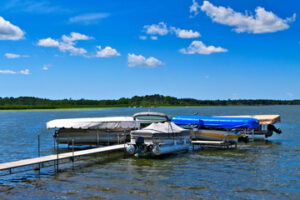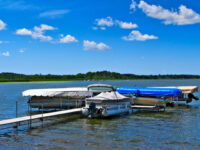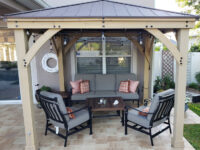Benefits of Using Dock Lifts for Loading and Unloading
Quickly transfer loads from any dock height to the truck bed using a loading dock lift. These hydraulic scissor lifts are available in surface or pit mount models.
Without a boat lift, your watercraft can bang against the dock, causing scuffs and scrapes. Dock Lifts Charleston SC can safely suspend your watercraft above the dock during storage, reducing this damage.
Using a dock lift for loading and unloading allows you to eliminate the need to climb up or down from the truck. This eliminates the potential for back, shoulder and hand injuries. It also eliminates the need to restack goods for transport. These types of injuries are costly and can be very dangerous for employees.
Dock lifts can be used with a wide range of material handling equipment including two wheel dollies, hand carts and hand pallet trucks as well as powered equipment like power pallet trucks and counterbalanced stackers. The simplest models can be operated by a man standing on the dock or a powered vehicle. More complex units have a control panel located inside the vehicle to operate the dock lift.
A key safety feature of most dock lifts is the ability to stop the cycle of a dock leveler until the vehicle restraint arm is in place. This prevents the forklift from accidentally rolling off the dock while loading or unloading a trailer. It also prevents a forklift from driving through an open overhead door.
Another way to ensure loading dock safety is by requiring your operators to use wheel chocks. These wedge shaped blocks are placed in front of the rear wheels of a trailer to keep it from moving away from the dock during loading. By making it a requirement to use the chocks and having the ability to easily verify that they are in place, your workers can greatly reduce the risk of trailer creep injuries.
Several other safety features are included in most dock lift models. These include an emergency velocity fuse that stops the hydraulic system if line breaks. Most dock lifts feature beveled toe-board provisions around the entire platform and ramps. One-piece bridge construction eliminates pinch hazards to hands and feet, a problem with scissor dock lifts that have manual “throw over” plates. Superior Handling Equipment dock lifts also come standard with the Speed-Lift patented design with Automated Folding Ramps to increase safety.
When choosing a dock lift for your application it is important to choose one that is rated for the load you will be lifting. You can do this by adding the weight of your goods to the weight of the lift and the weight of the transport equipment. Then choose a model with that capacity or higher. Also, make sure the lift fits your existing dock by measuring your slip width before you buy it. This will save you from having to rework your dock or spend money on additional accessories that may not work with the lift.
Convenience
A dock lift is a great way to keep your boat safely elevated in the water, eliminating the need for constant tying and untying dock lines. It also allows you to easily access your watercraft from shore or trailer without needing to haul your boat around with a winch. This can save you a lot of time and effort, and makes boating much more enjoyable and relaxing.
A boat lift can also help you avoid expensive repairs and maintenance, by keeping your watercraft safe from the elements. It can prevent rust, corrosion and water damage by keeping your boat out of the sun and rain. This can help prolong the life of your boat, and ensure that it remains in excellent condition.
In addition, a boat lift can make loading and unloading trucks much faster and easier. This can be particularly important when you are receiving a variety of different truck types and sizes. It can also reduce the risk of injury to employees by allowing forklifts or pallet jacks to handle loads rather than people.
Choosing the right dock lift for your needs can be tricky. For instance, you need to consider the size and height of your boat, the type of water you’re in and whether you want a stationary or mobile unit. If you’re unsure about what lift is best for you, you should ask a professional. They can help you find the right model to suit your needs and budget.
Some dock lifts are designed to be used on the ground instead of in a pit, which can save money on construction. They can be installed on a flat concrete slab, and they can still offer the same level of functionality as recessed units. These units come in a range of platform sizes and capacities, and they can be purchased with or without side off-loading configurations.
Other options include wheels to provide rolling for load transport and positioning; and hand or safety rails to provide worker protection and to block off sections of the scissor lift when it is in operation. They also have a hydraulic power unit and a control box that can be mounted in the ceiling of your warehouse or on the dock. Some of these units can be operated with an optional remote control that enables personnel to move the platform and check on load status from outside the building.
Environmentally Friendly
The use of dock lifts allows equipment to move palletized loads between truck and ground level rather than relying on human power. This reduces worker injuries that are caused by bending, twisting and lifting and can be quite expensive. Using dock lifts also minimizes damage to products and goods by eliminating the need for manual movement. This can be particularly important if your business receives a large number of shipments with irregular sizes, shapes and quantities.
Generally, dock lifts require little or no maintenance and are very durable, so they will last far longer than their less durable counterparts. Moreover, since they can accommodate a wide variety of trucks and other types of vehicles, they are a good investment for facilities that receive many deliveries from different vendors. In addition, dock lifts allow for a more even distribution of weight over the vehicle axles. This can significantly reduce tire wear. In contrast, truck tailgates restrict vehicle range and often require frequent servicing resulting in high operating costs that are passed on to your customers.
In addition, some types of dock lifts (especially the top-of-ground units) don’t require a pit to operate, which can save considerable money during installation. These units can be installed on a concrete slab, and the top-of-ground design prevents the problems associated with recessed lifts that require pit construction such as drainage issues and interference with underground utilities.
The construction materials used in the manufacture of a dock lift are also highly eco-friendly. Some are made from recycled materials, which can help prevent the consumption of finite resources and avoid deforestation. Other options are built from wood, which enables you to utilize a renewable resource while also reducing the carbon footprint of your facility.
Another eco-friendly aspect of a boat lift is that it keeps your boats out of the water. This can greatly reduce the costs of cleaning and painting with antifouling chemicals. In addition, it can help prevent the growth of colonies of algae and mollusks that can cause serious damage to your hull over time.
Affordable
A dock lift gets your boat out of the water quickly and easily without much fuss. Since they have few moving parts and don’t require complex technology, they’re a lot less expensive to purchase and maintain than other lift styles. In addition, they’re highly affordable to install. You’ll save thousands, if not more, on the cost of a conventional or PWC lift.
Depending on your needs, dock lifts can offer a variety of additional features and options. Some have tilting and rotating functions, wheels for transport and positioning, hand or safety rails, and truck mounting. They can also be actuated with various methods, including manual cranks and screws, foot pumping and ratcheting, pneumatic air cylinders and air motors, hydraulic cylinders and motors, or electric motors.
Recessed or Pit Mounted
The equipment costs for recessed dock lifts are often less than that of top-of-ground units. They are also more convenient to use because they are mounted flush with surrounding surfaces, making them less of an obstacle for vehicle traffic going over the unit. They are ideal for warehouses and other industrial buildings that receive deliveries from a wide range of vehicles at different loading heights, especially semi trailer trucks.
These dock lifts can be lowered to ground level or to a fixed dock height, and come standard with a ramp that transitions loads from the platform to the truck bed. They are also available with optional folding split steel bridges that can be used to bridge the gap between the dock lift and the truck bed. They are also compatible with most trailers and have a maximum service height of 20 feet.
There are many factors to consider when choosing a dock lift, such as the maximum lifting capacity, the vertical lift travel, and the platform width and length. You should also pay attention to the roll over capacity, which is the maximum axle load allowable for vehicles driving over a fully lowered lift. Most recessed dock lifts are rated for 10,000-lb slow speed drive over, which is more than adequate to handle typical truck loads. If you have large specialty vehicles, however, be sure to check the manufacturer’s specifications for specific limits.






